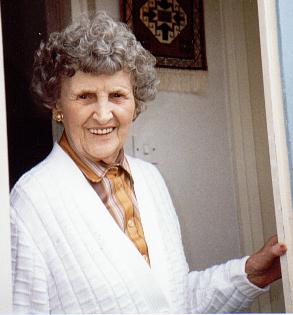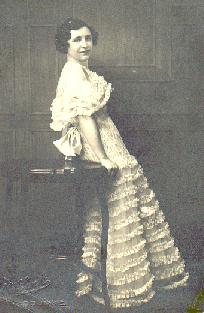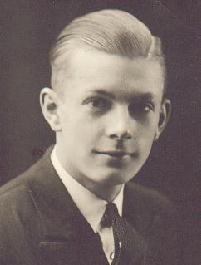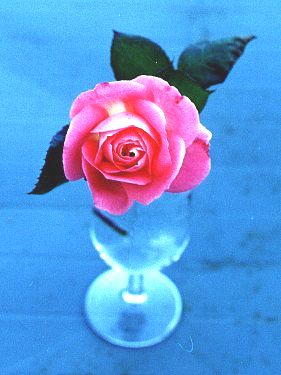 |
Trissie
Carlton
(1907-1999) |
Every town
and village has its share of characters whose memories bring the past alive and so it is with Mrs Trissie Carlton whose life mirrored the life and times of Bourne for practically the entire twentieth century.
She died a few days before the new millennium at the age of 92 but her daughter Anne who was aware of the legacy of recollection that filled her mother's mind had the foresight to record her talking about past events on video shortly before and this film now forms part of the oral tradition of Bourne, a mixture of anecdote and local history for future generations to enjoy and to help them understand the way it was.
Trissie was born at No 16 West Street, Bourne, on 28th May 1907, the only daughter of Mr and Mrs Joseph Burchnell, although they also had three sons. Perhaps the most unusual thing about Trissie was her name which was chosen by her father but the vicar, the Rev Hugh McNeil Mansfield, refused to christen her saying that it was not a proper name and it should be either Patricia or Beatrice, and so her parents took her to St Michaels and All Angels Church at Edenham village for the ceremony and Trissie she became. Who remembers that vicar now? Everyone remembers Trissie.
She became a pupil at the Bourne Abbey Road Primary School and had hoped to continue her education at the new grammar school which was then under construction but the premises were not ready and so she left school at 15 and stayed at home with her mother to learn cooking and housekeeping. These domestic duties however were short-lived because the chance of a job came her way and it was one that was to have a dramatic impact on her future life.
One of the clerks at the Mays Chemical Manure Company had broken an arm and someone was needed in the office to help out for three months. Trissie was not keen but her father insisted that she give it a try and she did so well that at the end of her temporary appointment she was given a full time clerical job with the firm where she stayed for the next fifteen years, learning shorthand and typing and what we would call today public relations because it brought her into contact with many of the firm's important customers who produced rugs and shoes from the sheepskins and leather they supplied.
The business was run by Thomas Mays (1856-1934), a prominent businessman and Justice of the Peace who was chairman of Bourne Urban District Council for several years. He was also an early motoring enthusiast, a passion shared by his son Raymond whom Trissie came to know well. After public school, Raymond had been commissioned in the Grenadier Guards in 1918 but resigned from the army the following year and went up to Cambridge to read engineering at Christ College but he spent more time on cars than on his studies and returned home to join the family firm and to enter the world of motor racing. She became his secretary, doing his paperwork in her spare time while the company was still paying her wages. She was therefore on hand to witness all of the trials and tribulations over the birth of English Racing Automobiles or E R A, the forerunner of the B R M that eventually broke the foreign domination of Grand Prix motor racing in the years that followed the Second World War.
Trissie remembers these formative times in vivid detail, particularly during the mid 1930s, the constant quest for sponsors and for capital to keep the project going, to finance the new car and to pay the men's wages. "Money was slow in coming in", she recalls, "and it was a week to week nightmare to provide money for the workforce. Even after the car project got off the ground and came into its own, money was always short."
This meant that Raymond had to make frequent trips to London to see wealthy and influential friends to raise more funds and often Trissie was left in sole charge at Bourne. On one occasion, Raymond announced that he was off yet again to London next day even though a new draughtsman was arriving for a job interview and staying overnight at the Angel Hotel. "You can't go", pleaded Trissie. "You must see him." Raymond replied that she should do the interview for him because his London trip was far more important to raise much-needed cash, otherwise the men's wages would not be paid that week. Trissie was worried that her stature prevented her from carrying the necessary authority because she stood only one inch over five feet tall and could barely see over Raymond's imposing desk but a high chair was moved into the office from the house and the interview went off as planned. The draughtsman got the job and stayed with the firm for many years and Raymond came back from London with the necessary finance to keep the firm going for another week.
The intimacy of these memories is quite touching for it reveals that as well as being a secretary, Trissie was also a friend and confidante of Raymond who had a penchant for stylish living and the theatre and as a result, she met the many celebrated visitors invited to his home in Eastgate, Bourne, including show business personalities Noel Coward and Ivor Novello and stage stars such as Jose Collins, Norma Shearer, Mary Ellis and Phyllis and Zena Dare. As the cars he made became famous, Raymond also took her to many events, hill climbs and races, where she rubbed shoulders with the famous. One of the most memorable friendships was with Prince Bira, son of the King of Siam, whose father had bought him one of the E R A cars for his 21st birthday. "Walk with me Trissie", the prince would say, "because you make me feel tall and I look just like a boy beside Raymond." There is also a tale that reveals Raymond's superstitious nature. A gipsy knocked on the door one day but Trissie sent her away empty handed and when he found out what had happened, Raymond instructed her to fetch her back and give her something. "It is bad luck to turn a gipsy away in this fashion", he said, "and she should be told to call here whenever she is in the vicinity."
Trissie celebrated her 21st birthday in style and although Raymond was out of the country, he gave her a cheque to buy herself a special dress to wear at her celebration party. Later, when she announced her intention to marry Rhead Carlton, she complained about the difficulties in obtaining 2½ size shoes. "Oh, no problem", said Raymond. "Peter Lilly will send us some" and a few days later four pairs of the right fit arrived from Lilly and Skinners, the well-known firm of London shoe stores that saw her through many years ahead.
 |
Trissie in the dress
bought by Raymond Mays for her 21st birthday (left) and Basil
Boothroyd, the young bank clerk who was among her first boy
friends (right).
Photos: Courtesy
Anne Boggitt |
 |
Trissie won many hearts in her lifetime among them a very young Basil Boothroyd who was to become a distinguished writer and broadcaster and a regular contributor and later assistant editor of Punch. His love for her was apparent in a photograph he gave her while working as a bank clerk in Bourne about 1927 for he wrote on the back: "Triss! Never a day goes by without your name passing my lips. Just look at this sometimes and remember - Your Basil."
He also sent her many poems including this extract from a very youthful effort that must remain one of his few unpublished works:
|

|
Every morning when I rise
I seem to leave a Paradise
That no-one knows but you and I
- What golden opportunity!
For in my dreams I know a place
Where I can always find your face
- Where I can read in your dear eyes
Such grand impossibilities.
|
But Basil left Bourne to pursue his career in journalism and as a playwright, B B C scriptwriter, lecturer and public speaker, and he also wrote a highly acclaimed biography of Prince Philip. He and Trissie never met again although they exchanged occasional letters and after two marriages, Basil died in Sussex in 1988 at the age of 78.
Trissie married Rhead Carlton at Edenham village church where she had been baptised on 20th June 1938 after staying in the village for the required legal period to enable the banns to be read. He was a year older than Trissie and they went to live in a rented house at 28 North Road which they eventually bought and in 1953, he started his own business of undertakers and ironmongers at premises in Abbey Road that still flourishes today. The marriage was a happy one and they had a daughter Anne and celebrated their diamond wedding anniversary two years before Rhead died on 30th November 1990, aged 84.
The couple remained close friends with Raymond Mays, visiting him often and playing bridge on Thursday evenings at Eastgate House until he died in 1980. "On those occasions, I often remembered all of the wonderful people I had met through Raymond Mays", said Trissie. "He gave me the confidence to be with people from all walks of life on equal terms and I was always grateful for that. But for a long time while playing bridge in those later years, I did have a job in dropping the 'Sir' or 'Mr Ray' whenever I spoke to him".
Trissie was always busy, in the early years occupied with the local amateur theatrical productions, sport and other pursuits and later she played tennis and golf at several clubs including Luffenham Heath and Leicester Veterans and also became ladies' captain of the Skegness North Shore Club. She remained active until the end and she died at Digby Court, Bourne, on 20th December 1999.
The video was made towards the end of Trissie's life in 1999 and she saw the unedited version before she died. "She was thrilled with it and hoped that it would interest people who know and love Bourne", said her daughter Anne. "My mother always said that if she could have had her life over again, she would not want to change a single thing, not her job, her family, her boss or her husband, and to the very end she always believed that she had lived the best life anyone could ever have had."
|
*If anyone is interested in seeing this video, they should contact Trissie's daughter Mrs Anne Boggitt at 31 Kingsway, Bourne, Lincolnshire, PE10 9DP or telephone 01778 422240. |
See also Raymond Mays

Go to:
Main Index Villages
Index
|



